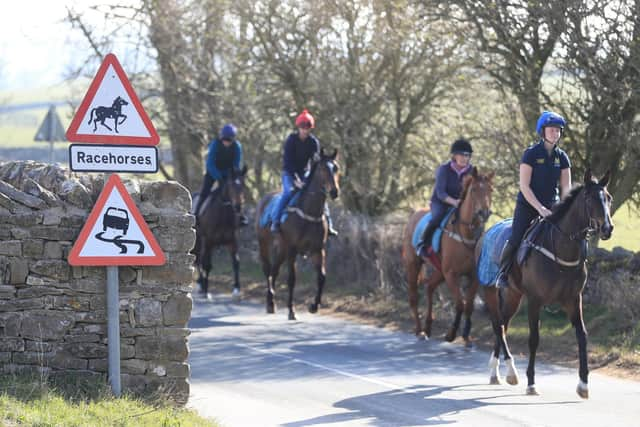Why the journey to a North Yorkshire gallops is like walking on ice for horses
A video conference meeting of North Yorkshire County Council today will hear proposals for a series of measures to enable the 791 horses stabled at 21 racing stables in Middleham to move safely to the gallops on moors above the town.
Members of the horse racing community have long complained about the surface of a 1.5-mile stretch of High Moor Lane – the only way for many of the trainers in the town to reach High Moor gallops – which becomes so treacherous many riders fear for their and their horses’ lives.


Advertisement
Hide AdAdvertisement
Hide AdThe riders also face having to cross roads and negotiate a seven per cent gradient north-facing slope to reach the 450 acres of gallops, which are the tracks used by flat and jump horses to train between race meetings, some 750 metres above the town.
The trainers, who pay the council to rent the gallops, said racehorses weighing around 500kg had gone down on the road close to riders, as the smooth surface had made it like walking on ice for the horses.
In recent years the situation has been aggravated as the route to the gallops, part of the 2014 Tour de France Grand Depart course, has been made extra smooth for council-sponsored cycling races, which reduces the grip for horses.
A report to the county council states it could be sued if found to have breached its statutory duty to ensure roads are not dangerous to traffic, which includes animals being ridden, led or driven.
Advertisement
Hide AdAdvertisement
Hide AdAhead of the meeting, Middleham’s racing trainers have called on the council to redirect some of the funding it would have spent on improving the roads to “motorway class” for the Tour de Yorkshire towards creating a solution for the town’s horse racing industry which even a decade ago was found to contribute over £15m a year to the local economy with year-round employment and supply chain contracts.
The county council’s recommendations include upgrading a right of way to a bridleway, investigating the potential of an equestrian crossing, derestricted speed limits and signs, supporting the Middleham Safe Roads for Horses Project and launch an annual survey of the skid resistance.
But trainer James Bethell, of Middleham Trainers Association, said some of the council’s proposed changes were “a non-starter” as a route past the town’s historic castle was not viable.
Mr Bethell said finding a solution to secure the safety of the horses on the roads had proved “a complete nightmare” as cyclists, who had been shown preferential treatment by the council, did not like road surfaces with extra grip.
Advertisement
Hide AdAdvertisement
Hide AdHonor Byford, a Middleham councillor and ex-chair of Road Safety GB, said during efforts to find a solution, it emerged that no research had been conducted over the biomechanics and materials interactions between the shod horse and metalled roads.
To remedy this the Middleham Safe Roads for Horses Project has brought together Royal Veterinary College biomechanics experts with Aston University material sciences academics to devise a road surface that would meet everybody’s needs.
According to Honor Byford, it should not be beyond the wit of man to “develop a road surface that has a better grip for horses and is more durable, so you don’t have to replace it every other year”.
She said while the county council had been supportive of efforts to improve road safety in Middleham, if it adopted the experts’ findings it would show a long-term commitment, and enable the project to apply for funding from other sources.
